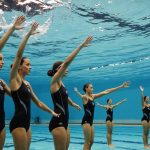Importance of Peripheral Vision in Basketball
Peripheral vision plays a crucial role in basketball. It enables players to be aware of their surroundings without directly looking at every detail, maintaining better focus on both the ball and team strategies. This implicit skill supports court awareness, giving players the ability to process and react to movements swiftly.
Enhanced peripheral vision allows athletes to predict movements more effectively, leading to improved basketball performance. By seeing a larger part of the court, players can make faster, more informed decisions. This ability to see the ‘bigger picture’ aids in recognising opportunities and threats from opponents, enhancing both offensive and defensive strategies.
Also read : Mastering the game: proven strategies for uk basketball players to boost hand-eye coordination in shooting
Several studies highlight the link between peripheral vision and higher performance metrics. Research suggests that players with refined peripheral vision often outperform their peers in situational awareness and decision-making. This underscores the importance of training peripheral vision as part of a holistic approach to athlete development.
A keen peripheral sense can also boost a player’s confidence, knowing they can rely on their visual acuity to aid in complex game situations. By integrating peripheral vision training into regular routines, players can elevate their overall game, contributing significantly to both individual and team successes.
In the same genre : Boosting performance: essential tactics for uk basketball players to conquer mid-season challenges
Techniques to Enhance Peripheral Vision
Improving peripheral vision can be a game-changer for athletes aiming to excel in basketball. Employing a range of vision training exercises, players can expand their visual field and improve their focus. This paves the way for smarter decision-making and sharper court awareness, directly impacting basketball performance.
Vision Training Exercises
Start with simple exercises aimed at practising focus and expanding the visual field. For instance, holding up a finger in front of the face while concentrating on distant objects helps strengthen peripheral perception. As skills develop, incorporating balance and coordination exercises can further refine peripheral abilities. Combining these elements enhances the player’s ability to process their surroundings fluidly.
On-Court Drills
On-court drills should simulate real game scenarios, emphasizing peripheral awareness. Using cones and markers creates visual stimuli, challenging players to respond to varying positions. Team-based drills are also vital, encouraging communication and fostering a sense of area awareness. These practices enable players to react promptly to unexpected situations.
Technology Aids
Incorporating technology can elevate vision training effectiveness. Apps and tools like virtual reality systems offer immersive experiences, enhancing players’ peripheral vision in lifelike settings. Additionally, tracking software measures individual progress and identifies areas for improvement, allowing athletes to tailor their training accordingly.
Practical Tips from Experts
Incorporating expert advice can significantly enhance training effectiveness for peripheral vision in basketball. By listening to coaches and players who have tested various methods, athletes can gain insights into refining their skillset. Here’s how they make peripheral awareness a pivotal part of their routines:
Coach Insights and Strategies
Coaches emphasise the importance of integrating peripheral awareness into regular practice sessions. One effective strategy is including drills that require players to keep their heads up while maintaining focus on both primary and secondary visual tasks. This helps in sharpening court awareness and quick decision-making.
Testimonials from UK Players
Several UK players have lauded specific techniques that bolstered their peripheral vision. They share how visual training and on-court simulations have led to tangible improvements in gameplay. One testimonial highlighted the ability to anticipate opponent movements more accurately, leading to better strategic plays.
Modifying Common Drills
Adjustments to standard drills can target peripheral vision development more effectively. By adding elements that challenge players to monitor multiple moving parts simultaneously, these drills become more than just physical exercises. They evolve into comprehensive sessions that enhance players’ court awareness and responsiveness, optimising overall basketball performance.
Conclusion: Real-World Applications
Integrating improved peripheral vision techniques into basketball games can yield significant performance benefits. Players have recognised that enhanced visual skills boost their ability to execute strategic plays and react more effectively on the court. By adopting these methods, athletes can gain a competitive edge as they implement improved peripheral awareness into their gameplay.
Athletes who have expanded their peripheral field report a noticeable improvement in performance metrics. Enhanced vision allows for quicker recognition of play opportunities, leading to improved decision-making. Teams are able to coordinate better when each player can anticipate movements and respond exponentially faster to dynamic situations.
The evolution of training programs focusing on visual skill development demonstrates a promising future for players aiming to elevate their game. As more players share positive testimonials about their success with these techniques, a trend emerges, suggesting that training peripheral vision isn’t just advantageous but necessary for modern basketball performance. Teams adopting such training programs are likely to see not only improved individual performances but also greater overall strategic cohesion on the court, leading to a more successful season outcome. The future of basketball lies in the continued development of these visual skills, setting a new standard for player preparedness and court intelligence.











